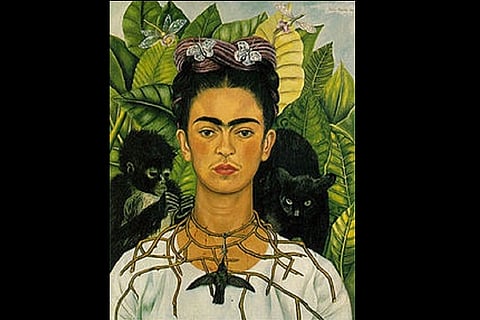Here’s looking at Frida Kahlo’s Self-portrait with monkeys
By Barry Carr, Emeritus Professor of History, La Trobe University
The glyph is identical with an image in the Florentine codex, a document with which Frida and Diego were familiar.
Many of Frida’s self portraits were commissioned. One of her first monkey paintings, for example, was bought in 1938 by the industrialist, philanthropist and first president of the Museum of Modern Art in New York City, Anson Conger Goodyear.
Goodyear was one of a group of wealthy figures, from business, publishing and Hollywood, as well as from the private sector and diplomatic circles in Mexico, whose commissions enabled Frida and Diego (both of whom were Communist revolutionaries) to pay for Diego’s lavish collecting and Frida’s onerous medical bills.
One of these patrons was Jacques Gelman, a Jewish exile from European fascism, who made a successful career in Mexico as film producer and early promoter of the actor Cantinflas. Together with his wife Natasha, Gelman assembled a spectacular collection of Mexican and European art. Some of their Frida and Diego paintings are now on show at the Art Gallery of New South Wales.
Frida Kahlo died in 1954, a short while after she had been carried in her sick bed to participate in a demonstration against US political and military intervention in Guatemala, where the CIA had helped overthrow the elected government of Jacobo Arbenz.
Following Mexican tradition, Frida’s coffin was laid out for viewing, and covered with the hammer and sickle flag of the Mexican Communist Party, which both Frida and Diego had rejoined in the early 1950s. The coffin was displayed at the Palace of Fine Arts, where leading figures in the art world and humble citizens came to pay their respects. The museum director was dismissed shortly afterwards for this political indiscretion at the height of the Cold War.
Frida’s room at the Casa Azul has been left as it was at the moment of her death. The Blue House, after all, was the place where she was born and where she and Diego lived for most of their lives.
It is also the number one site for fans on the pilgrimage route that now brings tens of thousands of travellers to Mexico City, attracted by a “Fridamania” fuelled by movies, fashion and a never-ending supply of consumer articles carrying the Kahlo brand.
(The article was first published on The Conversation.n You can read the original article here.)

